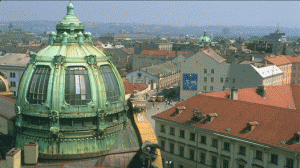
The Czech Republic, located in eastern Europe, contains two different regions, Bohemia and Moravia. Ethnically, 95 percent of the inhabitants are of Czech descent; Moravians are the largest minority. The Czechs settled Bohemia by the 6th century A.D., while the Moravians settled Moravia sometime in the 8th century.

The earliest recorded settlement at Prague dates from the 9th century; two castles were built: one at Hradcany and the other on the hill of Vyšehrad on the east bank of the Vltava river. The Old Town (Staré Mesto) dates from the 12th century, and the Square is now a popular spot with many sidewalk cafés.

Music has always played a major part in Prague’s cultural life; the city has been the home of Mozart, von Weber and Dvořak, among other musical greats (Mozart’s opera Don Giovanni was premiered here in 1787). Smetana Hall, located in Prague’s Municipal House, is named for Bohemia’s first major national composer, Bedřich Smetana (1824-1884).

St. Vitus’ Cathedral is situated next to the Hrad (Prague Castle, now the residence of the Czech President). Although construction began on the cathedral in the 14th century, it was not completed until 1929. The Chapel of St. Wenceslas (also known as “Good King Wenceslas”), contains the Czech crown jewels.

The center of modern Prague is Wenceslas Square, actually a long boulevard with the National Museum at one end. Once the city’s horse market, it is now flanked by hotels, stores and restaurants. Wenceslas I, Prince of Bohemia , was murdered on his way to mass in 929 and was canonized almost immediately afterward; the popular Christmas carol “Good King Wenceslas” is a commemoration of his piousness and charity.
